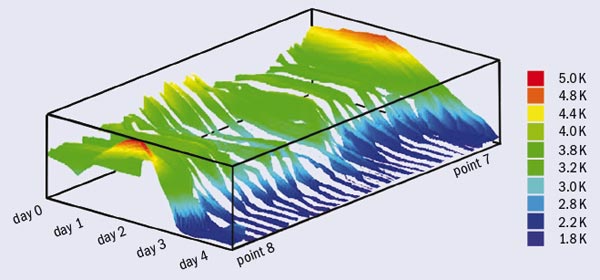The first sector of the LHC to be cooled reached its operating temperature of 1.9 K for the first time on 10 April. Although only an eighth of the LHC ring, this sector is already the world’s largest superconducting installation. This achievement marks the end of more than two months of commissioning work, which began in January and was carried out in three stages.
The 3.3 km sector comprises more than 200 dipole magnets and short straight sections, which contain quadrupole magnets, and has a total mass of 4700 tonnes. During the first stage, it was pre-cooled to 80 K, just above the temperature of liquid nitrogen. At this temperature, the material reaches 90% of its final thermal contraction, representing a 3 mm shrinkage for each metre of the steel structures. The total contraction over the sector as a whole is close to 10 m, and special devices (bellows and expansion loops) in the interconnections between the magnets compensate for this.

On 5 March, the teams began work on the second stage, which involved cooling the sector to 4.5 K using the gigantic refrigeration plants. For the final stage, which began in mid-March, the 1.8 K refrigeration plants came into play. These use a sophisticated pumping system to bring down the heat-exchanger saturation pressure to cool the magnets and the 10 tonnes of helium that they contain to 1.9 K. To achieve a pressure of 15 millibars, the system uses a combination of hydrodynamic centrifugal compressors operating at low temperature and positive-displacement compressors operating at room temperature. At 1.9 K, helium is superfluid, flowing with virtually no viscosity and allowing greater heat-transfer capacity.
The complexity and large number of sub-systems to be commissioned for the first time, together with various interface conditions to be managed, account for the time needed to cool the sector. The control system of one sector has to manage approximately 4000 inputs/ouputs and 500 regulation loops that need to be adjusted. In addition, the teams have carried out extensive checks to make sure that the cooling was done with all the necessary caution. This learning phase, which was long but vital, has also enabled the teams to prepare for cooling the other sectors.
While the sector cooling progressed steadily, problems arose in a different sector when a quadrupole magnet, one of an “inner triplet” of three focusing magnets, failed a high-pressure test at Point 5 on 27 March. Each inner triplet set of magnets contains two quadrupole magnets (Q2 and Q3) built at KEK and one (Q1) built at Fermilab. The asymmetric force generated during the test broke the supports, made of the glass cloth–epoxy laminate G-11, that hold the Q1 magnet’s cold mass inside the cryostat, and also damaged electrical connections.
CERN and Fermilab now know that this is an intrinsic design flaw that must be addressed in all triplet magnets assembled at Fermilab. Computer-aided calculations after the accident show that the G-11 support structure could not withstand the associated longitudinal forces. Review of engineering designs reveals that the longitudinal force from asymmetric loading was not included in the engineering design or identified as an issue in the four design reviews. An external review committee will analyse how this problem occurred and determine the root causes and the lessons learned.
The goal at CERN and Fermilab is now to redesign and repair the inner triplet magnets and, if necessary, the electrical distribution feed-box without affecting the LHC start-up schedule. Teams at CERN and Fermilab have identified potential repairs that could be carried out without removing undamaged triplet magnets from the tunnel. In the meantime, all three of the pressure-tested triplet magnets at Point 5, plus the associated feed-box, will be removed from the tunnel for inspection and, if necessary, repair.








